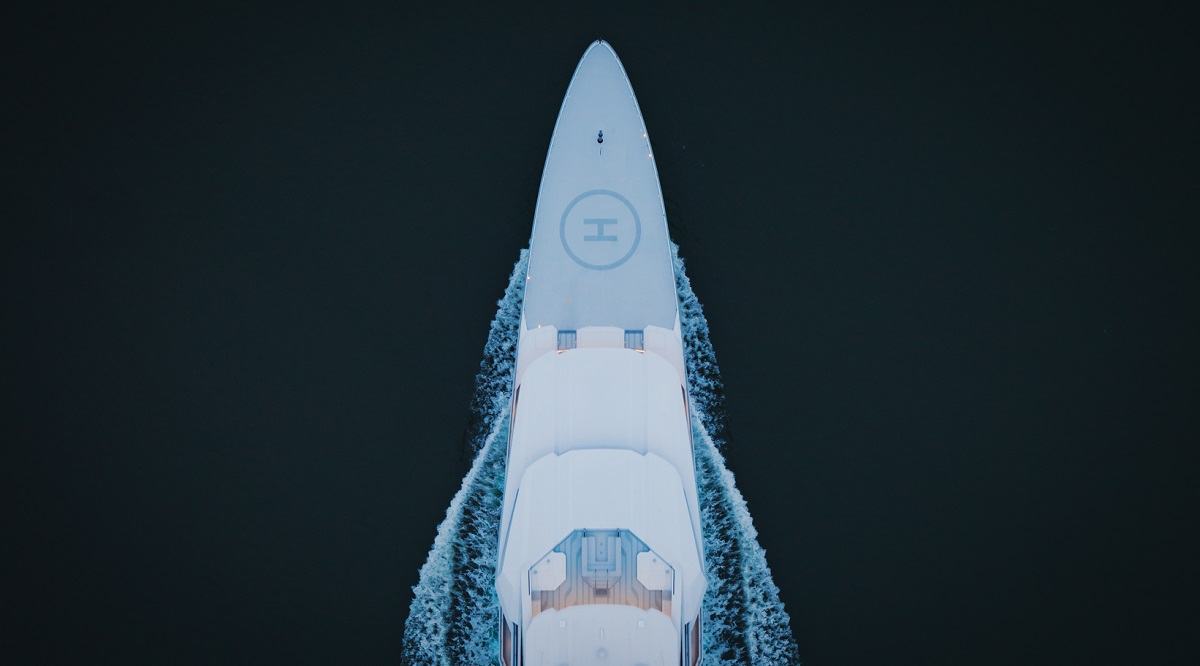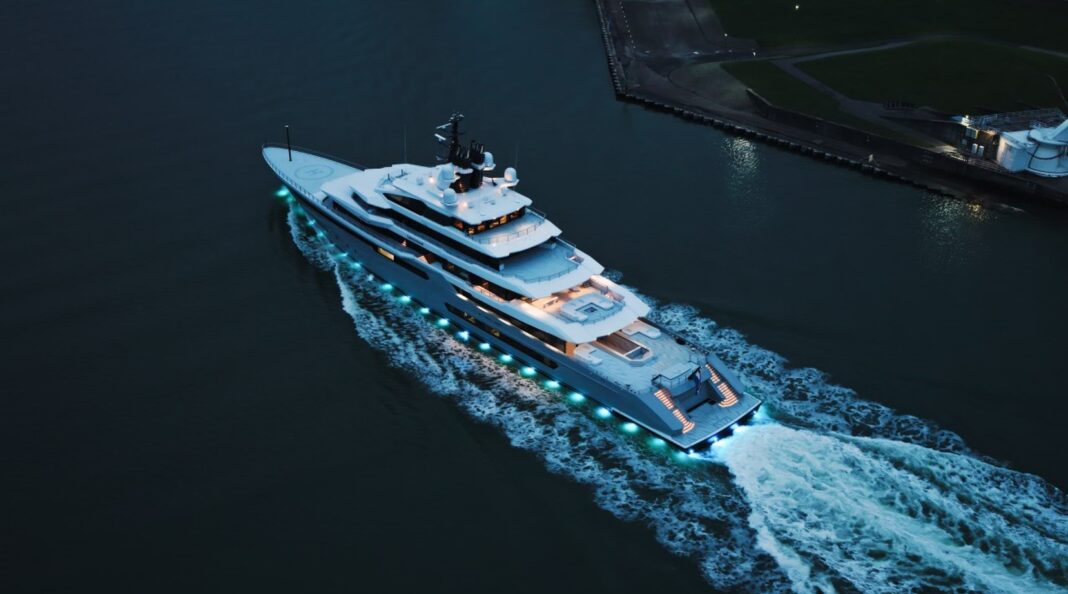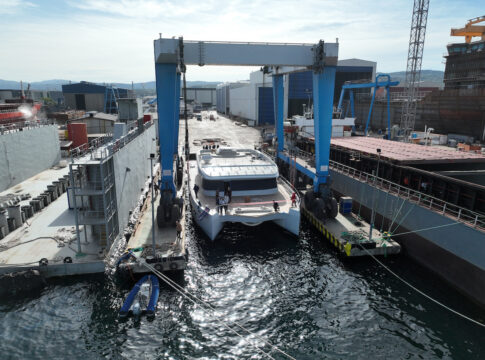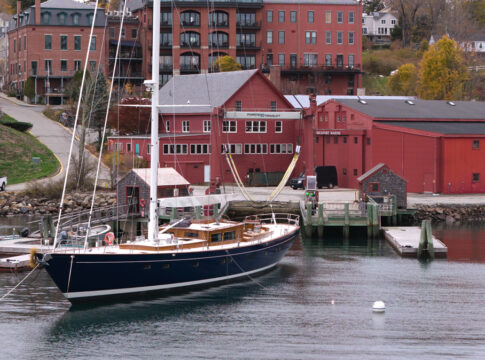Oceanco is proud to deliver Leviathan, formerly known as project Y722 – a 111m/363ft diesel-electric yacht that represents a new philosophy of yachting: one that places greater purpose on how yachts are built, operated and owned.
Her vision stems from the owner’s ethos of teamwork and community – a mindset that shaped Leviathan’s revolutionary layout, ergonomic design and the process that brought her to life.
Thanks to close cooperation between Oceanco, its Design team, Co-makers, Lateral and YTMC, Leviathan incorporates innovative solutions to enhance seakeeping and onboard comfort.
Through a combination of hull testing and optimization, technical platform configuration and focused efforts to reduce noise and vibration, she offers a unique experience for those living and working onboard.
“What makes Leviathan so unique is the way she came to life. From the very start, we knew nothing about her would be done in a traditional way,” says Oceanco CEO Marcel Onkenhout. “We were welcomed into the team alongside Gabe and everyone who would ultimately be involved in operating her. It is this level of collaboration that sets Leviathan apart from anything we’ve built before. We’re incredibly proud of the way she was developed, and following her successful sea trials, we can now say she’s the most comfortable yacht ever designed, built, and delivered by Oceanco.”
BUILT ON COLLABORATION
The project brought together the owner, Gabe Newell – working closely with YTMC and Y.CO – alongside the Oceanco Design team, Mark Berryman Design, the Leviathan crew and a network of Co-makers and suppliers. Gabe was closely involved throughout the design development and build, encouraging openness and collaboration across all parties. For Gabe, this process proved just as rewarding as the result.
“This iconic yacht started from a simple sketch, and the journey throughout has been extraordinary. It was an unforgettable human adventure that will forever be etched in our memories, leaving us with a profound sense of humility and satisfaction to what we have accomplished”, says Patrick Casanova from the Oceanco Design team.
“Working with the team at Oceanco is incredibly enjoyable and a lot of fun; everybody is professional, creative and dynamic,” Gabe comments. “We knew we were asking for unusual things, and Oceanco embraced it with open arms. Not only have we designed a very unusual yacht that leans into Oceanco’s strengths of innovation and design, but the team has also been willing to collaborate with us on evolving the process.”
As a lasting symbol of the collective achievement behind Leviathan, a glass panel engraved with the names of nearly 3,000 contributors is installed in the main staircase – just one of the many gestures of appreciation initiated by the team.
A HUMAN-CENTRED ENVIRONMENT
With accommodation for up to 26 guests and 37 crew, Leviathan’s interior layout was designed to combine guests with crew and foster a sense of shared experience. Prime locations usually designated for guest use only have been reimagined to equally welcome crew, reflecting the owner’s belief that a yacht should feel like a community and enable mutually enjoyable experiences.
This approach marked a shift in perspective for interior designer Mark Berryman Design. “With 28 years of experience designing superyacht interiors, we’ve encountered nearly every possible scenario – or so we thought,” says Mark Berryman. “Leviathan challenged convention in a completely new and exciting way from an operational standpoint.”
On the bridge deck, a communal gaming lounge resides where an aft saloon might typically be located, accommodating 15 gaming stations, two race simulators and ample lounge seating. The main deck saloon has been transformed into a spacious communal mess, featuring combined dining for up to 54 people.
Beyond enhancing the guest experience and sense of community onboard, this approach also supports a focus on crew wellbeing and long-term retention. In addition, the crew accommodation features oak and deep wenge finishes. Leisure areas are available for everyone, including a basketball court and recreational sun deck with whirlpool. The gaming lounge also serves as a quiet space for crew learning and development.
“She is not just a high-performance vessel,” adds Charlie Birkett, CEO and Co-Founder of Y.CO. “She is a working ecosystem, designed to support everything from world-class hospitality to scientific research. That is what happens when you put people and purpose, at the center.”

ERGONOMIC DESIGN
Operational efficiency was a key driver behind many of the design and material choices onboard Leviathan, without compromising on quality. These decisions support the owner’s goal of freeing crew time from routine maintenance so they can focus on higher-value tasks, from enhancing guest experiences to their own development and wellbeing.
“We adopted a crew-centric approach that really digs into how Leviathan is operated and maintained,” says Gabe. “The goal was to consider where the most valuable experiences occur for the community of people onboard. By increasing crew productivity, we can enable them to focus more on engaging with guests and creating meaningful experiences for everyone.”
The Bolidt decking, which features a custom pattern inspired by the yacht’s exterior, is fully synthetic and chosen for its durability and low maintenance. Bead-blasted stainless railings and synthetic handrails reduce the need for polishing. Even the off-white exterior paintwork was selected to help minimize cleaning.
In a collaborative effort between Bolidt, Oceanco and the crew, the compound used for the decking was specifically developed for Leviathan to improve heat dissipation – an example of Oceanco’s commitment to driving industry innovation.
For the exterior, Gilles Vernhet and the entire Oceanco Design team blended functionality with distinctive design. “Conceived through a bold vision that merges a striking forward-leaning silhouette with strong prismatic forms, Leviathan maintains a sense of fluidity throughout. Its distinctive blend of materials, finishes, and colours—especially on the deck—elevates the design, positioning her as a truly avant-garde vessel,” adds Gilles.
On the interior, Mark Berryman Design worked closely with Leviathan’s crew to incorporate operational insights and create a practical and efficient workplace. Leathered and honed stone finishes were selected for their durability and ease of cleaning, while natural wool carpets were chosen for their resilience and low maintenance.
ENGINEERED COMFORT
During the development phase, Oceanco and Lateral worked with MARIN to undertake extensive model testing, to optimize seakeeping and onboard comfort. Leviathan’s hull represents the latest evolution of Lateral’s DE-Series, a hull form family that originated with the D-Series, first developed in 2010.
Since then, custom evolutions have been applied across multiple projects and continuously refined in close collaboration with MARIN. The DE-Series has been specifically engineered to meet the performance demands of large yachts operating at moderate speeds with podded propulsion, and Leviathan showcases its most advanced and optimized form to date.
Leviathan’s exceptional seakeeping performance, both at anchor and underway, has been achieved through a comprehensive model testing focused on optimizing beam, waterplane shape and GM targets to optimize roll period and roll comfort.
To further enhance performance, a seawater ballast system was incorporated, enabling the yacht to maintain optimal loading conditions. With a natural roll period exceeding 12 seconds, and a stabilization system combining Quantum MagLift and XT Fins, Leviathan delivers superior onboard comfort across a wide range of operating conditions.
“Sea trials has given us great confidence in the vessel. She handles beautifully and truly shows her full capabilities at sea. What stands out most is just how remarkably quiet she is, the low noise and vibration levels are extraordinary, even at full speed,” said Leviathan Captain, Alan Pike. “She’s an absolute pleasure to be onboard. The entire crew all worked on this project for quite some time, and seeing her out on the water and preparing to deliver her to the owner is a wonderful moment for everyone involved.”
Leviathan is equipped with two ABB DO980P Azipods, with the design prioritizing exceptional noise and vibration comfort while maintaining an optimal balance with propulsion efficiency.
The Azipod arrangement and custom five-blade propellers were carefully engineered in close collaboration with ABB to deliver ultra-low pressure pulse levels. Model-scale cavitation testing enabled precise tuning of the final propeller design to meet exact performance targets. In parallel, the stiffness of the steel Azipod foundations was optimized to minimise both high- and low-frequency hull vibrations.
A 5.5 megawatt-hour battery system enables silent nighttime operation, enhancing onboard comfort. Its peak shaving capabilities also support optimal engine performance, improving fuel efficiency and reducing engine running hours and extending maintenance intervals.
Thanks to Leviathan’s diesel-electric drive, the engine room is positioned further forward than on a conventional yacht of this size. This allows greater flexibility in layout, enabling more guest accommodation to be positioned aft – an area traditionally occupied by the engine room and typically one of the most comfortable parts of the yacht in terms of motion. To maintain smooth operation in higher sea states, the hull doors use an innovative adjustable hinge developed by Winel that stays horizontal to the deck, avoiding slamming and reducing crew intervention.
“A refined electric architecture forms the core of Leviathan’s technical backbone, leveraging the latest generation of hull design from Lateral” explains James Roy, Lateral’s Managing Director. “Sea trials have evidenced exceptional levels of comfort in seakeeping, noise, vibration and operational performance.”
Additional efforts were made to reduce other onboard noise sources. For example, extensive lab testing was conducted to study how sound from a central ventilation unit travels through HVAC ducting into cabins. “We built a full-scale mock-up of all components and measured noise levels,” says Deniz de Koningh, Project Director at Oceanco.
“These results were used to fine-tune our acoustic models, which we then applied across the entire yacht. This level of research and optimization has never been done at this scale before.” Window noise was also addressed through lab testing. “We analyzed how external vibrations translate into internal noise and optimized both the construction and the way the windows were integrated into the yacht to minimise sound transmission,” adds de Koningh.
Operability and reliability were critical for the owner’s technical team. “Building redundancy into auxiliary systems and electrical architecture was key to helping the crew maintain seamless service and operations without added pressure,” says Dan Morgan, Managing Director of YTMC.
A custom air filtration and monitoring system from VFA Solutions – a specialist in air cleaning and purification – was integrated to improve onboard air quality. Leviathan is among the first yachts to implement this system at such scale and complexity.
A PLATFORM FOR IMPACT
Leviathan joins Inkfish, an organization run aboard Gabe’s fleet of vessels which support scientific research and marine exploration. Inkfish provides researchers with access to remote environments and the coveted technology on their vessels. One of the unique offerings Inkfish has for the scientific community is the full ocean depth submersible on R/V Dagon, which has already been to the deepest known parts of the ocean and continues to make breakthrough discoveries with every dive.
Leviathan is the latest addition to the Inkfish fleet, with onboard facilities designed to accommodate scientific activities. These include a fully equipped dive center, laboratory, and an onboard hospital – occupying the space traditionally reserved for a beach club. A 3D printing workshop allows the crew to produce spare or replacement parts onboard, supporting self-sufficiency during extended or remote cruising.
“Yachts have great potential to serve as platforms for scientific research,” says Gabe. “It’s about recognizing that you’re part of a broader community and ensuring the yacht’s presence adds value to the communities around it.”
Leviathan sets a forward-thinking example of how yachts can be built and used– encouraging industry development, creating onboard community and contributing long after delivery. A symbol of how yachting can evolve through people, performance and purpose, we are excited to see how she will shape the future of the industry.






